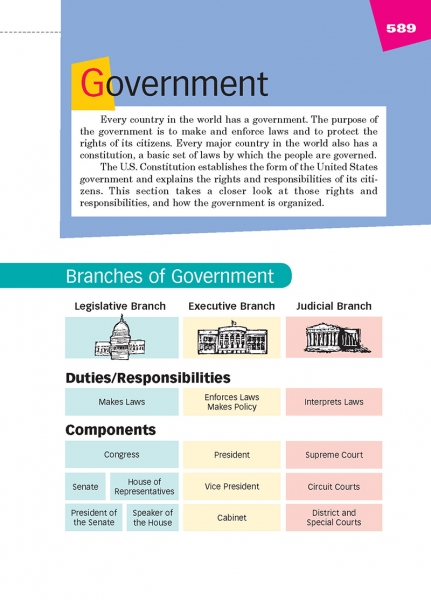Page 589 from

Start-Up Activity
Ask students which they trust most: the president, the Congress, or the Supreme Court. You may be shocked to hear that students don't trust any of them very much.
If that is the case, they are just like the founders of the United States. The reason for having three branches of government is to divide power so that no single person or group can rule the country alone. The system of checks and balances was created to hobble government, to avoid dictatorships. The colonists had suffered under just such dictatorships prior to the revolution, which is what inspired the Constitution. Each branch had different duties:
- The legislative branch (Congress) makes the laws.
- The executive branch (the president) enforces the laws.
- The judicial branch (the Supreme Court and other courts) interpret the laws.
To demonstrate this separation of powers, split your class into groups of three. Have them choose a legislator, an executive, and a judge. Then ask the group to come up with a new classroom rule. Afterward, have each group of three present their new rule. The legislator should describe the rule. The executive should tell what happens if anyone breaks the rule. The judge should tell what the rule means, when it applies, and why it is in place. As well as fostering much conversation, this activity will also create much confusion and frustration—just as democracy always does.
Think About It
“To make democracy work, we must be a nation of participants, not simply observers. One who does not vote has no right to complain.”
—Louis L'Amour

Start-Up Activity
Ask students which they trust most: the president, the Congress, or the Supreme Court. You may be shocked to hear that students don't trust any of them very much.
If that is the case, they are just like the founders of the United States. The reason for having three branches of government is to divide power so that no single person or group can rule the country alone. The system of checks and balances was created to hobble government, to avoid dictatorships. The colonists had suffered under just such dictatorships prior to the revolution, which is what inspired the Constitution. Each branch had different duties:
- The legislative branch (Congress) makes the laws.
- The executive branch (the president) enforces the laws.
- The judicial branch (the Supreme Court and other courts) interpret the laws.
To demonstrate this separation of powers, split your class into groups of three. Have them choose a legislator, an executive, and a judge. Then ask the group to come up with a new classroom rule. Afterward, have each group of three present their new rule. The legislator should describe the rule. The executive should tell what happens if anyone breaks the rule. The judge should tell what the rule means, when it applies, and why it is in place. As well as fostering much conversation, this activity will also create much confusion and frustration—just as democracy always does.
Think About It
“To make democracy work, we must be a nation of participants, not simply observers. One who does not vote has no right to complain.”
—Louis L'Amour